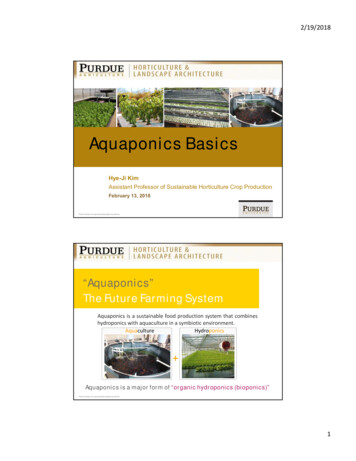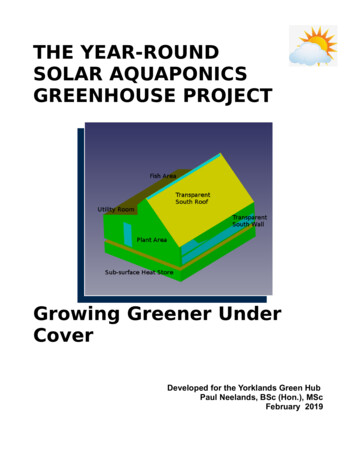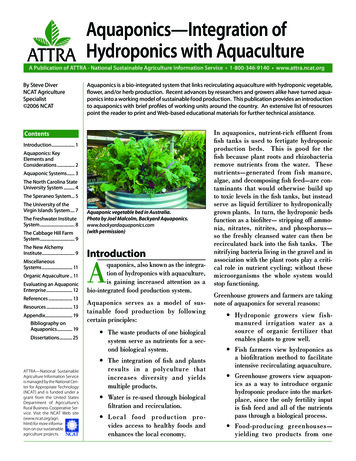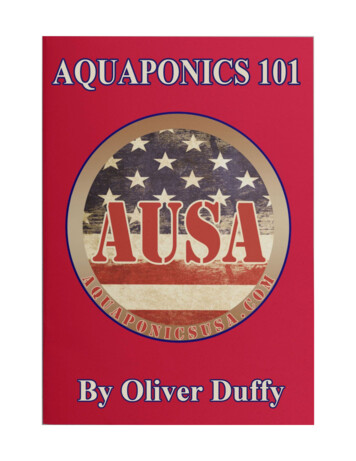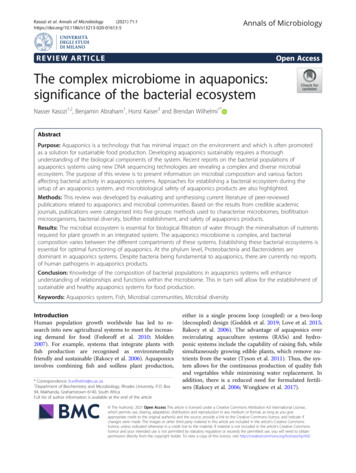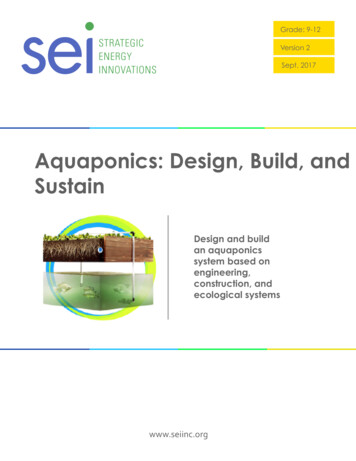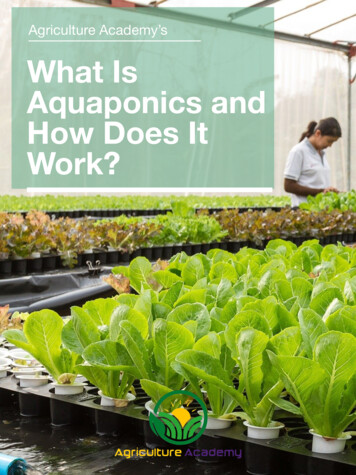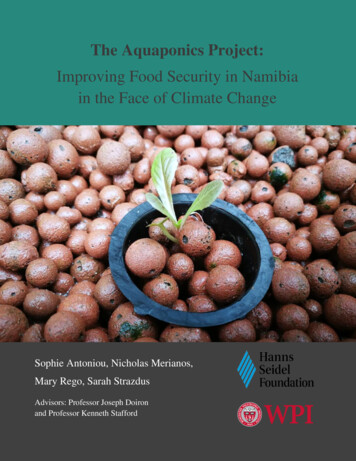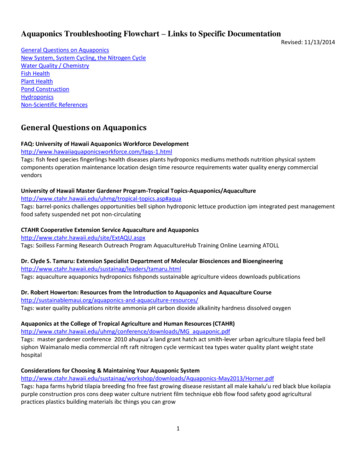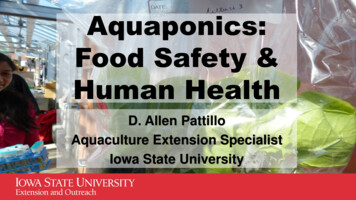
Transcription
Aquaponics:Food Safety &Human HealthD. Allen PattilloAquaculture Extension SpecialistIowa State University
Introduction Food safety is a concern– little is known about foodborne diseases in aquaponics systems Foodborne diseases– Annually responsible for 76 million illnesses, 325,000 hospitalizations, and 5,000deaths– Result in 10 - 83 billion in pain and suffering, reduced productivity, and medicalcosts annually Specific concern with aquaponics– Proximity of fish culture water to edible plant culture
Introduction Fish generally not regarded as a food safety threat inaquaponics– Temperatures of culture water are low– Thought that establishment of pathogens is not promoted (e.g. Escherichia coli or Salmonella spp.) Potential for survival and growth is really unknown Evaluation of this assumption is needed
Who is Responsible for Safe Food? ProducersHandlersProcessorsFood SuppliersConsumerswww.fightbac.org
Aquaponic Food SafetyMicrobial Threats (Greatest to Least)1)2)3)4)5)6)Listeria monocytogenesSalmonella spp.Shiga-toxin E. coliVibrio spp.Aeromonas spp.Shigella spp.7)8)9)10)11)Campylobacter spp.Pleisomonal shigelloidesEdwardsiella tardaCrypyosporidoumLeptospira spp.
Food Safety Threats(Greatest to Least)Painter et al. 2013
Why is produce risky?1. Raw2. Wrinkly– High Surface Area3. Sticky– Covered in Biofilm
Biofilms and Pathogens Plant matter is coated in a living substance calledbiofilm that contains beneficial and harmfulmicrobes Biofilms are sticky and may harbor pathogens like:– Listeria– Salmonella– Aeromonas
Listeria monocytogenes Survives with or withoutoxygen Grows well inrefrigeratortemperatures Very highly pathogenic
Salmonella spp. Very common in wildbirds and rodents Can persist in water orwet, cool environmentsfor months Can contaminate feed
Aeromonas hydrophilia Associated with fish andwater Probably high infectiousdose Immunocompromised peopleare at risk
Vibrio spp. 3 main speciesincluding Cholera Aquatic bacteria Often associated withshellfish
Escherichia coli (O157H7) Not carried by fish– Cold-blooded Contamination likelybecause of pooremployee hygiene
Non-Bacteria Cryptosporidium– Calves (or people) Cyclospora– Mexican raspberries Giardia– Person – water – person Protozoans are Resistant to chlorine!!
How are pathogensintroduced to produce? HandsAerosolsDirect water contactInternalization?– New study shows E.coli actually inside of lettuceplants
Reducing Food Safety Risks Good Agricultural Practices (GAPs) Use of water and food sterilization methods– Ultraviolet Irradiation– Ozone– Hydrogen peroxide– Others
Good Agricultural PracticesGAPs help reduceGAPs include:contamination risks for: Food Safety Plan SoilWaterHandsSurfacesPM 1974A – On-farm Food Safety: Guide to Good Agricultural Practices ices-GAPs
Good Agricultural PracticesGAPs help reduceGAPs include:contamination risks for: Food Safety Plan SoilWaterHandsSurfacesPM 1974A – On-farm Food Safety: Guide to Good Agricultural Practices ices-GAPs
Food Handling Tips-Health, Hygiene & Hand-washing Sick workers should not handle food Proper handwashing techniquesto prevent crosscontaminationPM 1974B – On-farm Food Safety: Food Handling -farm-FoodSafety-Food-Handling-Guide
Food HandlingTipsClothing &Footware Reducing crosscontaminationPM 1974B – On-farm Food Safety: Food Handling -farm-FoodSafety-Food-Handling-Guide
Food Handling TipsTraining &Documentation Training new workers onGAPs Keeping RecordsPM 1974B – On-farm Food Safety: Food Handling -farm-FoodSafety-Food-Handling-Guide
Food Safety PlanWhy have a food safety plan? Planning Training Liability Quality Control Crisis ManagementPM 1974A – On-farm Food Safety: Guide to Good Agricultural Practices ices-GAPs
Food Safety PlanWhat goes in a food safety plan?1.2.3.4.5.6.Production stepsHazard analysisControl pointsMonitoring strategiesAdjustment protocolsDocumentationPM 1974A – On-farm Food Safety: Guide to Good Agricultural Practices ices-GAPs
CategoryConcentrationProductsChlorine BleachProduce: 100-200 ppm 200 ppm 2 table-spoons of 6% hypo chlorite(household bleach) per gallon in warm water(75-120 F)Surface: Typically 50-100 ppm Unscented regular strength bleach (6%) Sanova (acidified sodium chlorineChlorine dioxide Less than 3 ppm in liquid form Zep Dominion Organic Acids Acetic Acid Citric Acid Lactic Acid Vinegars contain less than 8% acetic acid 8% vinegar with a ratio of 1 part vinegar to 3parts water Follow manufacturers’ recommendations Vinegar at less than 8% acetic acid from an organic source Veggixide (citric/lactic acid) PRO-SAN LC FIT (citric acid, grapefruit seed, ethanol)Hydrogen Peroxide Food grade hydrogen peroxide 1-5%; 3% mostFood grade hydrogen peroxidecommon Follow manufacturers’ recommendationsPeroxyacetic Acid / Follow manufacturers’ recommendationsPeracetic Acid Tsunami 100 (hydrogen peroxide/peroxyacetic acid) StorOx 2.0 (hydrogen peroxide/peroxyacetic acid) SaniDate 12.0 (peroxyacetic acid) StorOx (hydrogen peroxide/peracetic acid)PM 1974D - Guide to Liquid Sanitizer Washes with Fruit and Vegetables
Aquaponic FoodSafety Research atISU
IntroductionUse of ultraviolet (UV) radiation for sterilization in recirculatingaquaculture proven to reduce pathogen loads in waterNo chemical additions needed– increasing fish health– decreasing need for water exchangeEffective use of a UV sterilizer should reduce abundance of manybacterial and viral pathogens reduce probability of cross-contamination between water and planttissues
Study Objectives1) Identify the presence and abundance ofpathogens in an aquaponics system2) Evaluate the efficacy of UV sterilization insuppressing pathogens
27 in(69 cm)Dia. 200 Gal. 760 L35 Gal.133 L(2.43 m)(1.22 m)
456123
Barramundi (Lates calcarifer) Italian Largeleaf Basil Buttercrunch Bibb Lettuce
Study Design Study Period– November 11, 2014 – Present Plants germinated 4 weeks prior to stockingAll-male barramundi stocked at 236 63gFish Fed twice dailyWater quality recorded every morningWater chemistry analyzed twice weeklyCaCO3, NaHCO3, and Fe supplemented as needed
Study DesignPathogens Evaluated What?–––– HOW?E. coli/ColiformE. coli O157Salmonella spp.Aeromonas spp. Where?– Water– Plant AEROBIC PLATE COUNTS COLIFORM COUNTS
Study Results1) Identify the presence and abundance ofpathogens in an aquaponics system2) Evaluate the efficacy of UV sterilization insuppressing pathogens
Microbial Counts in LettuceMicrobial Load (CFU/g)Aerobic Plate Counts in Lettuce within Aquaponics876543210Food ( 7 CFU/g)123456Day of Sampling
Microbial Counts in LettuceMicrobial Load (CFU/g)Coliform Counts in Lettuce within Aquaponics31Food ( 2 CFU/g)22314506Day of Sampling
Microbial Counts in BasilMicrobial Load (cfu/g)Aerobic Plate Counts in Basil within Aquaponics9876543210Food ( 7 CFU/g)123456Day of Sampling
Microbial Counts in BasilMicrobial Load (cfu/g)Coliform Counts in Basil within Aquaponics3212Food ( 2 CFU/g)341560Days of Sampling
Microbial Counts in WaterAerobic Plate Counts in Water within Aquaponics7Microbial Load (cfu/mL)6514233241Drinking Water ( 2.5 CFU/mL)560Day of Sampling
Microbial Counts in WaterMicrobial Load (CFU/mL)Coliform Counts in Water within Aquaponics3122314Drinking Water ( 1 CFU/mL)560Day of Sampling
Microbial Counts in WaterMicrobial Load (cfu/mL)Aeromonas Counts in Water within Aquaponics11109876543210Drinking Water ( 10 CFU/mL)Day of Sampling123456
Discussion1) Identify the presence and abundance ofpathogens in an aquaponics systemDid we find potential pathogens?– Water - Yes– Plants - Yes
Discussion1) identify the presence and abundance ofpathogens in an aquaponics systemHow many Pathogens did we find?Test (logAerobic PlateCountsColiformCountsAeromonasBasil (CFU/g)2.70 - 6.540.00 - 2.47--Lettuce (CFU/g) 2.29 - 6.970.00 - 2.25--Water (CFU/mL) 0.00 - 6.550.00 - 2.472.23 - 4.4410)
Discussion2) Evaluate the efficacy of UV sterilization insuppressing pathogensDid UV reduce water Pathogen loads? Aerobic Plate Counts – Yes, briefly Coliform Counts – variable results Aeromonas – Somewhat– maintained 10 CFU/mL
Discussion2) Evaluate the efficacy of UV sterilizationin suppressing pathogensDid UV reduce lettuce Pathogen loads? Aerobic Plate Counts – Yes, briefly Coliform Counts – variable results
Discussion2) Evaluate the efficacy of UV sterilizationin suppressing pathogensDid UV reduce basil Pathogen loads? Aerobic Plate Counts – Yes, briefly Coliform Counts - no
Conclusions Aquaponic produce did contain foodborne pathogens– at times levels were above the safe threshold UV sterilization alone is not enough to eliminate foodsafety concerns for aquaponics
Conclusions Alternative methods must be explored to improve foodsafety in aquaponics to move the industry forward Potential methods– Water exchange– Improved filtration– O-zone
Research Sponsors
Food Safety Resources The Ohio State University– http://foodsafety.osu.edu/ Iowa State University– http://www.extension.iastate.edu/foodsafety/ University of Minnesota– www.Extension.umn.edu/foodsafety Penn State– http://extension.psu.edu/food/safety
References Painter, J. A. , R. M. Hoekstra, T. Ayers, R. V. Tauxe, C. R. Braden, F. J. Angulo, and P. M. Griffin.2013. Attribution of Foodborne Illnesses, Hospitalizations, and Deaths to Food Commodities by usingOutbreak Data, United States, 1998–2008. Emerging Infectious Diseases. 19, 3.http://wwwnc.cdc.gov/eid/article/19/3/11-1866 articleShaw, A., C. Strohbehn, J. Meyer. 2013. PM 1974D - Guide to Liquid Sanitizer Washes with Fruit andVegetables. Strohbehn, C., P. A. Domoto. 2013. PM 1974C – On-farm Food Safety: Cleaning and SanitizingGuide. n C., M. Smith, P. A. Domoto , L. Wilson. 2011. PM 1974B – On-farm Food Safety: FoodHandling Guide. -Food-Safety-Food-HandlingGuideStrohbehn, C., D. Henroid, J. Ellis , L. Wilson. 2004. PM 1974A – On-farm Food Safety: Guide toGood Agricultural Practices (GAPs). APs
Questions?D. Allen PattilloFisheries and Aquaculture ExtensionIowa State University Pattillo@iastate.edu 515-294-8616
Introduction Food safety is a concern – little is known about foodborne diseases in aquaponics systems Foodborne diseases – Annually responsible for 76 million illnesses, 325,000 hospitalizations, and 5,000 deaths – Result in 10 - 83 billion in pain and suffering, reduced productivity, and medical costs ann
